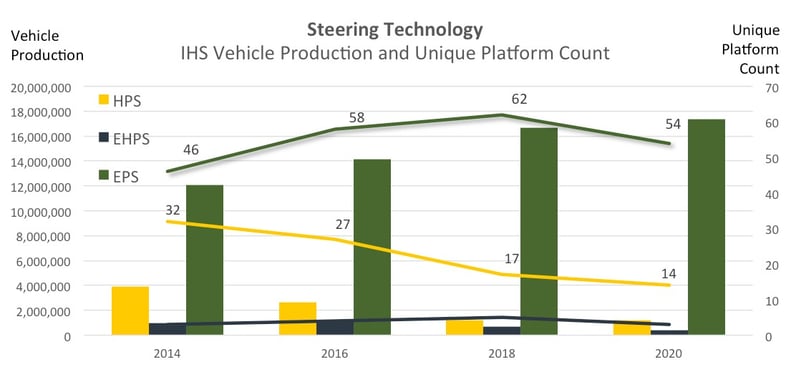EPS and Steering Technology Trends [IHS Data]
 The power steering market has seen multiple developments in steering technology over the years, but perhaps the largest platform transition in history is happening right now. More rapidly than ever, vehicle manufacturers are changing to a fully electronic power steering assembly in all or a majority of their new year models. Anecdotally, the industry's switch to an EPS platform may not seem like something that needs to be a huge concern for power steering businesses and remanufacturers, but taking a look at the power steering market by the numbers can truly reveal the massive scope of the transition that's going on in our industry.
The power steering market has seen multiple developments in steering technology over the years, but perhaps the largest platform transition in history is happening right now. More rapidly than ever, vehicle manufacturers are changing to a fully electronic power steering assembly in all or a majority of their new year models. Anecdotally, the industry's switch to an EPS platform may not seem like something that needs to be a huge concern for power steering businesses and remanufacturers, but taking a look at the power steering market by the numbers can truly reveal the massive scope of the transition that's going on in our industry.
In this post, we'll provide IHS data and statistics on EPS and steering technology trends in recent and coming years as well as discuss how these trends will affect the future of the aftermarket steering industry.
IHS Steering Technology Trends and Projections

In the data available from the IHS, production and unique platform counts are revealed for electronic power steering (EPS), electrohydraulic power steering (EHPS, a hybrid platform), and hydraulic power steering (HPS) from 2014 through 2020. As we compare the data over the years represented, it's clear to see that EPS is far and above the most common steering assembly and owns the vast majority of market share. Here's what we see:
- In 2014, in North America, the technology split on new vehicles showed that EPS was already far ahead of the other types of platforms at 71%. During that same year, only 6% of new vehicles used EHPS and 23% were hydraulic.
- To compare, in 2016 in North America, only two years later, EPS had captured even more of the market and risen to installation in 79% of new vehicles produced that year. EHPS stayed fairly static as the smallest player in the industry with 6% while traditional hydraulic power steering fell to only 15% installation in new vehicles.
- Finally, the IHS data also shows projected production data for 2020, which forecasts EPS hitting an all-time high. By 2020, 92% of new vehicles produced will be equipped with electronic power steering platforms. In contrast, both EHPS and HPS will continue to plummet to just 2% and 6% of the market, respectively.
The Future of Aftermarket Steering Reman
EPS has been a much-discussed topic in the automotive and power steering industries for years. As EPS technologies and systems continued to develop and become more efficient, beneficial, and therefore widely used by auto manufacturers, the numbers began to show how big of a player EPS was becoming and would become in the future. As we near 2020 and EPS technology is more widely adopted than ever, you'll undoubtedly begin to experience the effects of the industry shift that once seemed far off and, perhaps, out of sight and out of mind.
With EPS production reaching about to reach its highest peak yet, now is the time for power steering businesses and remanufacturers to ensure that their shops are prepped and ready for the EPS vehicles that will soon make up the majority of the work coming in. EPS service and rebuilding looks a lot different than the hydraulic vehicles your team is used to, and EPS technology is a stepping stone to the autonomous vehicle technology that's right around the corner. In order to stay on top of your competition and stay in the power steering game, you should be starting your transition to EPS service as soon as possible.

